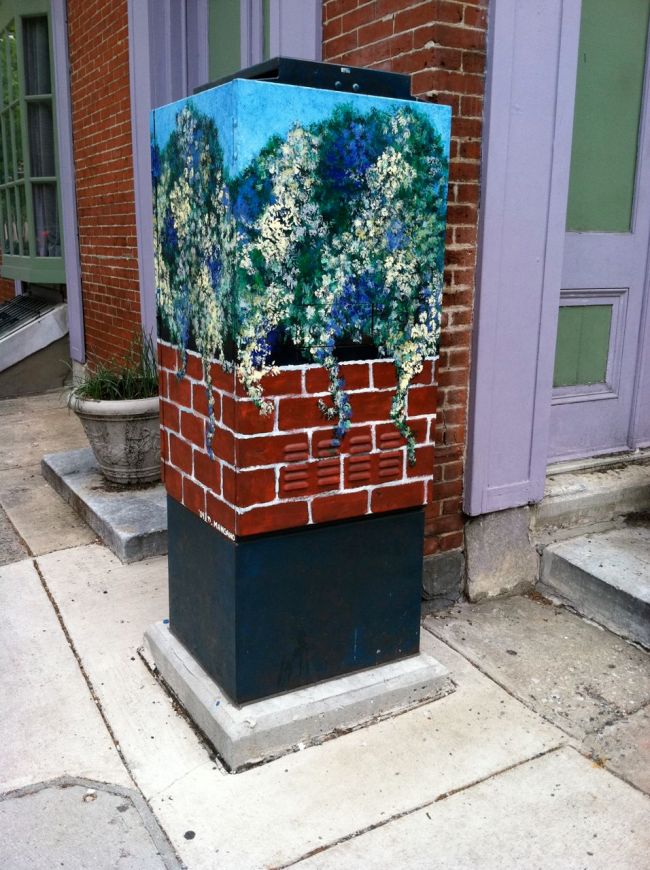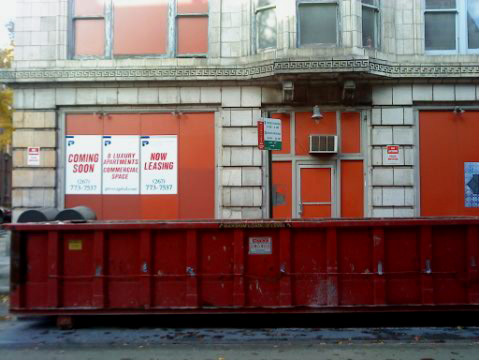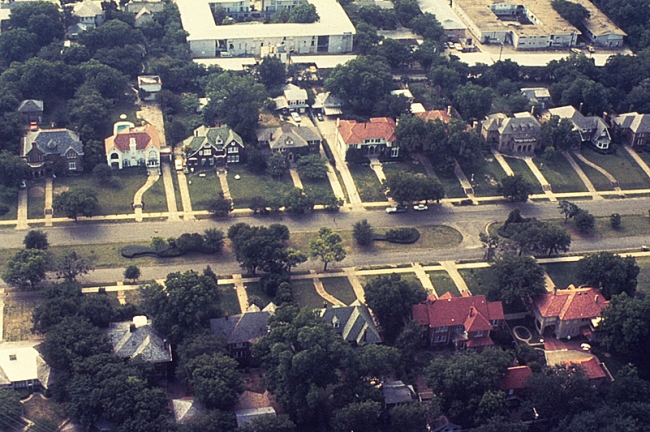It snowed in Philadelphia – again – yesterday. But already the piles of white that had turned grey, slushy and icy are melting and the water is flowing into the storm sewers and thence to the rivers.

A proposed rowhouse block urban watershed project by North Street Design
The little rivulets of trickling water among the crunchy piles of snow lingering on the pavement remind me that beneath the city are ancient brick culverts not unlike the Paris sewers in miniature. In them: a spiderweb of historic streams and creeks that once knitted together the tiny communities and isolated residents of the lower Delaware and Schuylkill watersheds. In the 18th and early 19th century farmers, millers and factories relied on them. Wildlife and farm animals drank from them. They were pathways and destinations. And then, as the city spread across them, they were channelized, enclosed and undergrounded.
Reopening the historic creeks through the densely built city isn’t likely to happen. The city’s Water Department says that’s “crazy.” Nevertheless, Philadelphia architects Gavin and Juliet Riggall have a vision and a business built on capturing the rain and snow from the sky. These two friends of ours are working on plans for new watersheds in Philadelphia neighborhoods, creating both beauty and utility, which the Riggalls regard as two parts of the design whole.
Married and working together in their emerging young firm, Juliet and Gavin are committed to making a difference. North Street Design, which they started in 2008, is literally breaking new ground with a diverse portfolio and an even broader vision of how design can make positive change in Philadelphia and across the region.
We knew about their cool design aesthetic and commitment to making their residential clients feel comfortable living through the chaos and disruption of a home renovation project. My husband and I are one of those clients. But what I didn’t know until recently is the story of their partnership with another design firm in an award-winning project, “Waterwork.” It’s about empowering people in city neighborhoods to take control of the spaces they inhabit and helping to answer the question “”how do we turn vacant land into an asset in Philadelphia,” creating long-term solutions for the 40,000+ vacant properties in the city.

There are more than 40,000 vacant lots in Philadelphia. Urban Voids seeks to find ways to capture opportunity from them and making neighborhoods more livable and residents empowered.
The venture, in its fifth year, proposes to reclaim vacant sites and make them green filters by capturing rain water and redirecting its flow. The City Parks Association and the Van Alen Institute, sponsors of the Urban Voids design competition, praised the Waterwork proposal as they awarded it their Grand Prize: “This design strategy offers ecologically sound recreational and infiltration solutions for the use of naturally cleaned storm-water run-off.” The social and economic, not to mention ecological, benefits of the plan have captured the interest and involvement of Drexel’s Civil Engineering department, the City of Philadelphia Water Department and the Point Breeze neighborhood. There, the Riggalls and their partners are deeply involved in engaging the community in work on a green infrastructure master plan. What’s needed now is further funding to realize the plan.
Meanwhile, Gavin and Juliet are building a practice that responds to design challenges in a very personal way. “Good and beautiful environments make people happy,” says Juliet.
The couple met on their first day as graduate architecture students at the University of Pennsylvania’s Graduate School of Fine Arts. Gavin’s background and undergraduate education was in art, while Juliet arrived with a civil engineering degree – having switched from aerospace engineering when she saw that her desire to work on (literally) stellar structures like the International Space Station was less likely to be realized “than working on helicopters and cargo planes.” Both saw the creative and society-enhancing opportunities that architecture can, in its best incarnations, offer as a profession and a calling. While each spent time working for other firms, they say that their goals and aspirations are best fulfilled working in their own business.

The historic, Pennsylvania Railroad-built Cynwyd Station. Photo: the Lower Merion Historical Society
They are wisely diversifying their products and their skills to respond to a fluid and uncertain marketplace. They are not only designing but are involved in the fabrication and installation of rainwater harvesting devices and systems that offer the aesthetic and practical functions that they always demand from anything they’re involved with. Their current design projects include an exciting rain water harvesting installation on the historic Cynwyd train station as part of an extensive rehabilitation of that landmark by the Lower Merion Historical Society. The challenge there, remarks Gavin, is to appropriately integrate a 21st century technology and application with the historic architecture. Similar challenges will face them as they begin work soon on a rain water harvesting project at historic Woodford Mansion, in Fairmount Park, in collaboration with the Philadelphia Orchard Project and the East Park Revitalization Alliance.
They are busy, and excited about their prospects. Gavin describes the many nights at Penn Design when he slept under his desk: “Creation makes me happy – it’s a source of contentment.” I’ll bet he still sleeps at his desk occasionally, while the 3-D computer models he’s working on take their languorous time to render. Here’s hoping that the groundbreaking and poetic design ideas that the Riggalls are bringing to the social and economic environment in Philadelphia are as inexorable as the flow of water, falling from the sky, that flows into the streams and culverts and then gathers force and spills into the rivers that help define us as a city.
 This really warm weather brings out the walkers, including me, and a day of exploring Washington Square West confirms that Philadelphia is looking pretty great in all this sunshine. More historic streetlights are going up on South 12th Street; that block by the slowly rebirthing Odd Fellows Building really needs the light, notwithstanding the horrendous flashing LED’s washing the facade of the new nightclub next door. (And does anyone know what “The Leoncalvo” was, by the way?)
This really warm weather brings out the walkers, including me, and a day of exploring Washington Square West confirms that Philadelphia is looking pretty great in all this sunshine. More historic streetlights are going up on South 12th Street; that block by the slowly rebirthing Odd Fellows Building really needs the light, notwithstanding the horrendous flashing LED’s washing the facade of the new nightclub next door. (And does anyone know what “The Leoncalvo” was, by the way?) And then there are the Litter Critters: fanciful re-imaginings of the very functional and very boring Big Belly recycling and trash cans along the sidewalks of Headhouse Square and South Street. The exuberantly designed vinyl wraps encircling the trash receptacles would put a smile on any face with their individual personalities and colorful palettes.
And then there are the Litter Critters: fanciful re-imaginings of the very functional and very boring Big Belly recycling and trash cans along the sidewalks of Headhouse Square and South Street. The exuberantly designed vinyl wraps encircling the trash receptacles would put a smile on any face with their individual personalities and colorful palettes. 
















